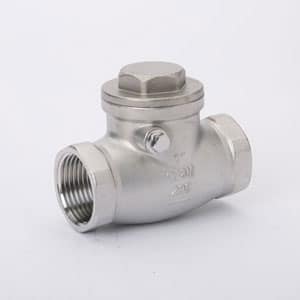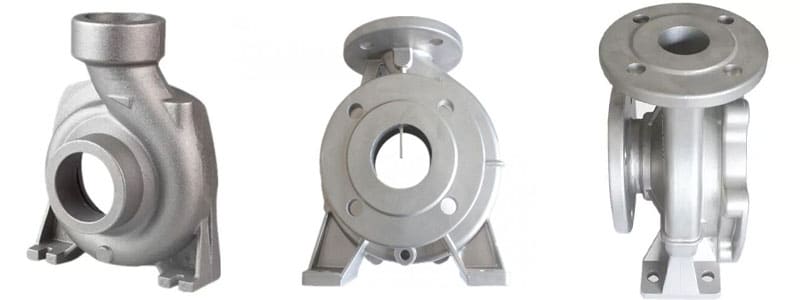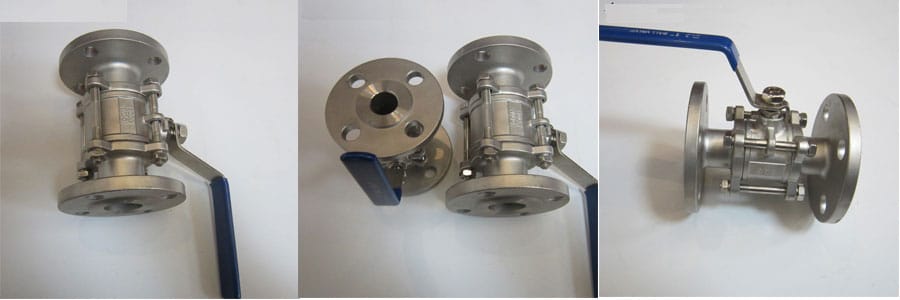Like other stainless steel alloys, CF8M stainless steel is one of the common grades used in investment casting. It is mainly used for pressure-containing parts. JC Foundry can produce CF8M stainless steel castings in various shapes for the different fields.

What is CF8M stainless steel ?
CF8M stainless steel is the most widely used US standard austenitic stainless steel casting grade. Its equivalent type is cast 316.
From the name CF8M, the letter “C” means the alloy is mainly for the purpose of corrosion resistance. The letter “F” is the approximate location on the iron-chromium-nickel (FeCrNi) ternary diagram. It indicates the iron, chromium, and nickel content. The number of “8” refers to the maximum carbon content in increments of 0.01%. it means the carbon content is 0.08%. The last letter “M” means that the Molybdenum element is present.
CF8M Stainless Steel Chemical Composition
CF8M is a cast austenitic material for pressure-containing parts. It is covered by ASTM A351 and ASTM A743, and ASTM A744 standard. There is a little difference in chemical compostions as below:
| Standard | ASTM A351 | ASTM A743 | ASTM A744 |
| Grade | CF8M | CF8M | CF8M |
| UNS | J92900 | J92900 | J92900 |
| C % max | 0.08 | 0.08 | 0.08 |
| Mn % max | 1.5 | 1.5 | 1.5 |
| Si % max | 1.5 | 2.0 | 2.0 |
| S % max | 0.04 | 0.04 | 0.04 |
| P % max | 0.04 | 0.04 | 0.04 |
| Cr % | 18.0-21.0 | 18.0-21.0 | 18.0-21.0 |
| Ni % | 9.0-12.0 | 9.0-12.0 | 9.0-12.0 |
| Mo % | 2.0-3.0 | 2.0-3.0 | 2.0-3.0 |
| Tensile, min, Ksi(MPa) | 2.0-3.0 | 70(485) | 70(485) |
| Yield, min, Ksi(MPa) | 30(205) | 30(205) | 30(205) |
| Elongation. Min, % | 30 | 30 | 30 |
ASTM A351 Standard Specification for Castings, Austenitic, for Pressure Containing Parts.
ASTM 743 and ASTM A744 Standard Specification are the same for Castings, Iron-Chromium, Iron-Chromium-Nickel, Corrosion Resistant, for General Applications.
CF8M Stainless Steel Properties Mechanical Properties
| Tensile strength (ksi): | 0.00-70.00 |
| Yield strength (ksi): | 30 |
| Elongation (%): | 30 |
| Hardness (Brinell): | 146.00-212.00 |
CF8M stainless steel Applications:
Stainless Steel SA-351 CF8M is a molybdenum-bearing modification of CF8 Austenitic Steel alloy. It is the cast equivalent of wrought AISI 316 stainless steel. The existence of molybdenum increases the general corrosion resistance and the resistance to pitting by chlorides. Mainly applications are for valve casting, flanges, fittings, and other pressure-containing parts. CF8M alloy is usually used as an unwelded part. Or can be solution annealed after welding. CF8M may be used at temperatures up to 1500F. It provides good corrosion resistance, availability, strength. Including coastal exposure.
CF8M Stainless Steel Casting
Like other stainless steel alloys (CF3, CF3M, CF8, CF8C, etc), CF8M material is one of the common stainless steel grades used in investment casting. JC Casting Foundry can make CF8M stainless steel castings in various shapes.
One question about CF8M Stainless Steel Casting
WHY ARE STAINLESS STEEL CASTINGS MAGNETIC?
Why CF8M (cast 316) Stainless steel is slightly magnetic? Some casting users are often accustomed to the “equal” wrought grade AISI 316. Because 316 is nonmagnetic.
AISI 316 stainless steel and ASTM CF8M stainless steel are called austenitic Stainless steel. But grades 430 and CB-30 are called ferritic Stainless steel. Their names are from the various crystalline structures which are found in steels.
Austenite is soft, ductile, and nonmagnetic. Ferrite is harder, less ductile, and magnetic. The proportions of these structures which are present in particular steel are determined primarily by chemical analysis although other factors may need to be considered.
CB-30 and 430 are strongly magnetic because they are ferrite. AISI 316 will seldom attract a magnet. Because it is all austenite. Stainless steel CF8M is magnetic because it contains 5 – 20 percent ferrite.
You may want to know why 316 and CF8M are so different if they are “equal.” Because reduction or elimination of ferrite makes the Alloy easier to roll into the sheet, bar, etc. So, the manufacturers of wrought material have adjusted the chemical composition to provide available property. But the casting industry does not have this restriction.
PS: What is the difference between stainless steel CF8M, SS316, F316, and TP316?
Answer: Yes, mostly they are the same. But they are defined in different standards. And their chemistry and property are a little different too.
- CF8M is defined in ASMT A351, ASMT A743 and ASTM A744, which is for casting purposes only.
- SS316 is defined in ASTM A240 and ASTM A276, it’s for plate, sheet, strip, or stainless steel bars.
- Grade F316, which is from ASTM A182 for Forged parts only. TP316 will be found in ATSTM A376 for pipe only.
If you want to buy stainless steel castings, kindly indicate CF8M stainless steel as material, otherwise, you can adopt SS316. This is VERY IMPORTANT!
SOME OF THE ADVANTAGES OF HAVING FERRITE IN CF8M ARE:
- 1-Increased strength. The yield strength of CF8M is normally 35,000 to 45,000 psi. If the composition were adjusted to cut the ferrite, the yield strength could be as low as 20,000 psi.
- 2-Increased resistance to stress corrosion cracking. Less severe consequences of intergranular corrosion. The chromium carbides form at the discontinuous ferrite/austenite phase boundaries. Not at the continuous austenite/austenite grain boundaries.
- 3-Increased resistance to cracking during welding and casting.
There are some disadvantages to having ferrite in this Alloy. It normally affects those castings used in specialized applications. For example, the devices using magnetic coupling must be made of nonmagnetic material. The Navy specifies nonmagnetic materials for minesweepers. Increased ferrite can reduce impact toughness at ultra-low temperatures (below -300 F). And after exposure to high temperatures (above 1000 F) although the latter is rare.
Another Question about CF8M stainless steel casting.
Q: This valve is cast based on the “CF8M” process. Can anyone help me why these 316 SS(CF8M) valves are corroding? Other valves are attracting the magnet why?
A. CF8M is the casting alloy that corresponds to the wrought 316 material. It has a slightly different chemical composition, which has several consequences.
1. Foundries usually balance the relative amounts of the various elements (while maintaining each within its own specified range) so that the microstructure is predominantly austenitic. But typically 5-8 percent ferrite. The ferrite phase is attracted to a magnet (if it is present to say 5% of the structure, the strength of the attraction will be in the vicinity of 5% of that of mild steel).
2. A consequence of the ferrite is an increase in strength during and immediately after solidification. It greatly reduces the possibility of hot-tear defects occurring which would require subsequent repair by the foundry
3. An incidental benefit is that the room temperature yield strength is increased, although this benefit is rarely exploited by design engineers.
4. An incidental benefit is enhanced corrosion resistance because the chromium specification range for CF8M is higher than that for 316. Furthermore, it is usual to manufacture CF8M towards the top end of its chromium range as part of the ferrite-inducing element balance. But to manufacture 316 towards the bottom end of its chromium range as part of the ferrite-avoiding element balance.
5. All of the above relies on the manufacturer heat treating the product appropriately. So as to avoid the presence of any carbides, or sigma phase, or chi phase, in the microstructure because any of these will detract from corrosion resistance.
CF8M stainless steel casting Process
JC casting is an investment casting foundry. Most stainless steel casting process is Silica Sol lost wax investment casting process.
About the investment casting, the stainless steel casting Process, stainless steel casting manufacturer of JC casting, you can check below
CF8M stainless steel casting Products
CF8M Pump Casting

CF8M Valve Casting

CF8M stainless steel casting Supplier Contact
If you have any inquiries about CF8M stainless steel casting or other stainless steel castings. Kindly contact us. Our professional sales team and technicians will reply to you within 12 hours.
